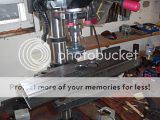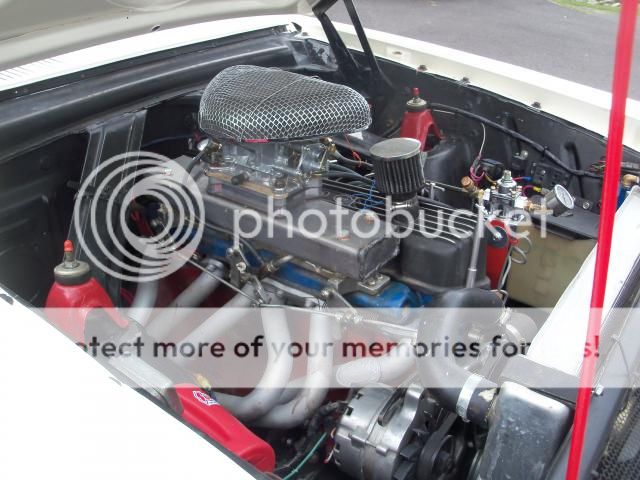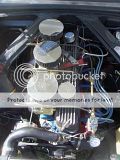Plenty of info, it just hasn't been stickied. If you surf the net, you see 1965 Jikov tri power inlinesix all over the place as a video poster.
Here, there is an epic six page post by
echo1955 viewtopic.php?t=63640
And other posts as well from frequent fliers
http://www.fordsix.com/forum/viewtopic. ... 47#p541547
2-bbls are better for fuel surge control and consistency in a drag racing environment. The fact is, there is probably about 25 more hp to be had with a well matched 500 cfm Holley 2-bbl on a 200 verses the best tripower 34 Weber on a 200. The big throat 1904 and 1101/1940 big throat carb combo can make 220 on a 250, but either way, you will get great results with Tripowers if you use the right carbs.
Your peak 1.5"Hg carb cfm as you would measure a 4-bbl, with the smallest 1100's, you'd be lucky to get 255 cfm. With good kinds of 1100's and 1101's is just over 445 cfm.
Rated as a 2-bbl, that's 360 to 630 cfm, as good as or better than the 7448 350cfm, 4412 500cfm or 6425 650cfm 2-bbl Holley
Despite being down over 200 thou for venturi size, a set of three 34 Weber ICT's with 1.147" 29 mm venturis flows best at 466 cfm total, which is equal to the best triple large venturi 1.352" 1940 Holley, at 449 cfm. That's 659 or 636 cfm.
To get the best combination of cfm and peak power, you have to hunt around to find the right carbs and the right small chamber 170 head, preferably with the bigger log.
The limitation is that the three holes to the log head limit the total cfm to well below those 360 to 658 cfm 2-bbl ratings. The intake manifold casting is the pinch point, with the early head before 1967 especially bad, the later C9 heads with the bigger than 1.5" hole a lot better.
Our overseas guys from Holland like
jdn21758 and other poster children of TriPower goodness exist, its not fair to single any out.
But here's just a faction of them. There are
hundreds.
JOHN G http://www.fordsix.com/forum/viewtopic.php?t=20605
64falconsix http://www.fordsix.com/forum/viewtopic.php?t=58378
64 200 ranchero Outer Weber ICT's, inner 1101, but he's had lots of other Holley 1-bbl combos
http://s1028.photobucket.com/user/64200 ... t=3&page=1
powerband has just about every type of 170/200/250 tri power and 2-bbl carb log combo I6 made
memberlist.php?mode=viewprofile&u=97
datac viewtopic.php?t=70151
kevinl1058 viewtopic.php?t=64712
FalconSedanDelivery
viewtopic.php?f=40&t=41798&p=502631#p502631
FalconSedanDelivery":mvy2nx2n said:
Finally got to test My 250 Engine ,in My 65 Mustang , Best Et was 14.55 @ 90.97, Terrible 60ft times ( Need More Converter ) will be installing a Higher stall unit to be ready for the 3 day race at my home track, 13's should be the result " Beaver Springs Dragway ", --http://beaversprings.com/ 250 .040, 1100 center, Little Holleys on ends , Crane Solid Cam .460int, .480exh Duraspark ign with GM 4 pin Module , 12-1 compression ( head was milled .120 , Deck .100 , Clifford Headers twin outlet ( open exh Drag car only ) car is a 1965 Mustang 3.50 gears C-4 with 10 inch converter ,( out of my 68 Blown 390 car ) 26.5 Slicks , Moroso Electric Water pump drive , adjustable Rockers , port divider in head , shift at 5000 , 4300 thru the traps
FSD set up is very creditable 200-225 flywheel hp, and most likely the most powerful triple 1-bbl around. He ran a unison linkage, high initial advance of 16 to 18 degrees, total timing to 30 degrees its all in at 2350, decked block 100 thou and head 120 thou for huge 12.3:1 C/R, and the worlds neatest tri power intake ever seen. His best was 14.39 @ 91.76 mph one hot June 2011, and was shifted at 5000 and 4300 at the traps, earlier runs were 5200 and 4700 rpm. He ran with 3.5:1 gears for the 14.39. Best 60 foot time 1.915 secs in a 2600+ pound car with a an estimated 165 at the rear wheels. That's a minimum of 220 hp with a C4, probably more
CobraSix, Slade has had Aussie 2V and tripower and
many informative posts like this
viewtopic.php?f=11&t=665&p=4483#p4483
The Tri Power has some serious short comings with some of the carb sizes and holes being woefully inadequate for performance, but anytime you have three jugs supplying fuel to six cylinders, the total system loss is less than the best 2-bbl direct mount.The two best recored hp tri-powers are kevinl1058's 200 and FalconSedanDelivery's 250, with flywheel hp, by my calculation, or 181 and 220 flywheel hp respectively.
The best thing about the tripower is fuel distribution. It makes up for its very bad porting sizes by having a very straight shot to the cylinders.
We have TOTALLY missed the lesson of the 1960's and early 70's Aussie and British triple carb I6 engines. In the 190 hp 15.3 second quarter mile 202 XU1 GTR, some of the the Healy 3000's, there were three 1.75" holes feeding each group of two cylinders, yet our, WITH RESPECT, stupid Offy and Edelbrock tripowers, we try to get away with 1.09" or 1.4375" on the outers, with 1.3, 1.65, or 1.75" on the centers. It was expedient as a solution, but dumb in 1960, and 1975, and is dumb now, yet we are still getting 181 hp from a 200 and 220 hp from a 250. And that shows how smart the US cam and exhaust tuners are.















